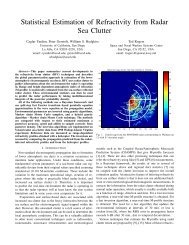Statistical Estimation and Tracking of Refractivity from Radar Clutter
Statistical Estimation and Tracking of Refractivity from Radar Clutter
Statistical Estimation and Tracking of Refractivity from Radar Clutter
You also want an ePaper? Increase the reach of your titles
YUMPU automatically turns print PDFs into web optimized ePapers that Google loves.
LIST OF FIGURES<br />
Figure 1.1: Tropospheric propagation conditions. Sub-refraction, st<strong>and</strong>ard<br />
refraction, super-refraction, <strong>and</strong> trapping (ducting). (Figure<br />
taken <strong>from</strong> [1]) . . . . . . . . . . . . . . . . . . . . . . . . . 4<br />
Figure 1.2: Most common three duct types. Evaporation, surface-based,<br />
<strong>and</strong> elevated ducts. . . . . . . . . . . . . . . . . . . . . . . . . . 6<br />
Figure 1.3: Vertical M-pr<strong>of</strong>iles, coverage diagrams, <strong>and</strong> clutter maps resulting<br />
<strong>from</strong> (a) a weak evaporation duct <strong>and</strong> (b) a strong surfacebased<br />
duct. . . . . . . . . . . . . . . . . . . . . . . . . . . . . . 9<br />
Figure 1.4: Effects <strong>of</strong> ducting on naval <strong>and</strong> communication systems.(Figure<br />
taken <strong>from</strong> [1]) . . . . . . . . . . . . . . . . . . . . . . . . . . . 10<br />
Figure 1.5: Sea surface grazing angle as a function <strong>of</strong> range for different<br />
evaporation duct heights computed using ray-tracing. . . . . . . 22<br />
Figure 1.6: An observation d is mapped into a distribution <strong>of</strong> environmental<br />
parameters m that potentially could have generated it.<br />
These environmental parameters are then mapped into the usage<br />
domain u. . . . . . . . . . . . . . . . . . . . . . . . . . . . . 23<br />
Figure 2.1: <strong>Clutter</strong> map <strong>from</strong> Space Range <strong>Radar</strong> (SPANDAR) at Wallops<br />
Isl<strong>and</strong>, VA. . . . . . . . . . . . . . . . . . . . . . . . . . . . 32<br />
Figure 2.2: Tri–linear M-pr<strong>of</strong>ile <strong>and</strong> its corresponding coverage diagram. 33<br />
Figure 2.3: The 4-parameter tri-linear M-pr<strong>of</strong>ile model used in this work. 33<br />
Figure 2.4: Full implementation <strong>of</strong> the MCMC algorithm: (a) burn-in<br />
<strong>and</strong> initial sampling phases in the original parameter space, <strong>and</strong><br />
(b) two parallel-running samplers operating on the new parameter<br />
l<strong>and</strong>scape after coordinate rotation. . . . . . . . . . . . . . 41<br />
Figure 2.5: Initial sampling phase - convergence <strong>of</strong> the model covariance<br />
matrix in terms <strong>of</strong> percent error. C m later will be used for<br />
coordinate rotation. . . . . . . . . . . . . . . . . . . . . . . . . 46<br />
Figure 2.6: Final sampling phase - Kolmogorov-Smirnov statistic D for<br />
each parameter. Used for the convergence <strong>of</strong> the posterior probability<br />
density. . . . . . . . . . . . . . . . . . . . . . . . . . . . 47<br />
Figure 2.7: Marginal posterior probability distributions for the synthetic<br />
test case. Vertical lines show the true values <strong>of</strong> the parameters.<br />
(a) exhaustive search, (b) Metropolis algorithm, (c) Gibbs algorithm,<br />
<strong>and</strong> (d) genetic algorithm. . . . . . . . . . . . . . . . . . 48<br />
Figure 2.8: Both 1-D marginal (diagonal) <strong>and</strong> 2-D marginal (upper diagonal)<br />
PPD’s for the synthetic test case obtained by the Metropolis<br />
algorithm. Vertical lines (in 1-D plots) <strong>and</strong> crosses (in 2-D<br />
plots) show the true values <strong>of</strong> the parameters. . . . . . . . . . . 49<br />
Figure 2.9: Wallops ’98 Experiment: SPANDAR radar <strong>and</strong> the helicopter<br />
measurements (37.83 ◦ N, 75.48 ◦ W) . . . . . . . . . . . . 50<br />
viii




